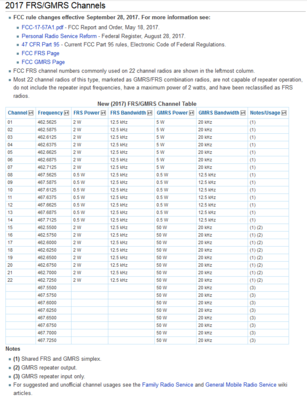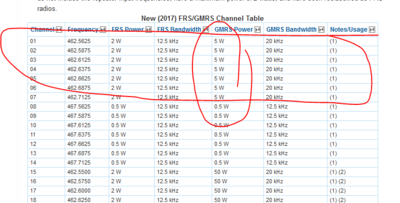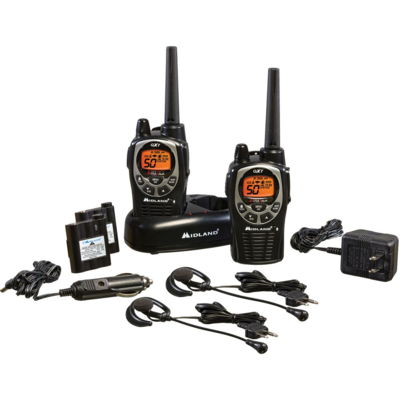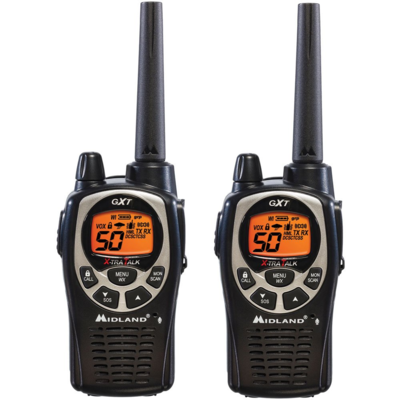I found this information on the MidlandUSA website and it was helpful to me.
The FCC requires a GMRS license as a way to regulate frequencies that are used by two-way radio devices. Before operating a GMRS radio, a consumer must have a valid license. Any radio using the shared FRS/GMRS frequencies that is able to transmit above 2 Watts of power was reclassified as GMRS only after the recent FCC Changes in September 2017.
We know the FCC website is a confusing place, so we are here to help demystify the GMRS licensing process. Fair warning, this might be dry but it is important information! Stick with us!
Top GMRS License Take-a-Ways
• Applicant must be 18+
• Not a representative of a foreign government
• Only available to individuals, aka no new business GMRS license (there are some that are grandfathered in, but that’s a different story circa 1987)
• No test, just payment; $70 and good for 10 years
• License covers you and your immediate family (husband, wife, kids, grandparents, uncles, you get the point!)
• If you have been convicted of a felony in the past, you will need to disclose more information as to the context of the charges (this does not mean you will automatically denied)
• And finally, follow the rules set forth by the FCC
Wait, What are the FCC Rules?
• If an authorized FCC representative request to inspect a GMRS station (This means anything GMRS; handheld, mobile unit, base units, etc), the operator must make the station and any station records available
• No messages in connection with any activity which is against Federal, State, or local law
• No false or deceptive messages
• No coded messages with hidden meanings (“10 codes” are permissible – CB users, you know what we mean but for those of you scratching your head check this link for a 10 Code List)
• No music, whistling, sound effects or material to amuse or entertain
• No ads or offers for the sale of goods or services
• No ads for political candidate or political campaign
• No international distress signals (like Mayday) unless in a vehicle in immediate danger
• No communicating with stations in the Amateur Radio Service, any unauthorized station, or to any foreign station
• No continuous or uninterrupted transmissions (unless communications have to do with the immediate safety of life or property)
• No messages for public address systems
• Must identify using FCC-assigned call sign at the end of transmissions and at periodic intervals during transmissions
That’s A Lot of Rules, Why do I Want GMRS Again?
Increased Power – Compatibility to FRS Radios – Repeater Capable – Low Cost
So, How do I Apply?
Online! Go to the FCC Website by following the information listed under “Filing Instructions” below. https://wireless2.fcc.gov/UlsEntry/licManager/login.jsp
Remember: you must register for a FRN as a Domestic Individual. This allows you to do business (ie. pay) the FCC. Once you receive your FRN, which typically happens moments after submitting the form, you are able to fill out the online application and purchase your GMRS license. Information directly from the FCC below.
Let’s get started!!
*BELOW INFO DIRECT FROM FCC HELP DESK*
New General Mobile Radio Service (GMRS) Filing Instructions
Per Public Notice DA 15-72, the FCC no longer mails license authorizations. If you provide an email address on your application, an official copy of your license will be automatically emailed to you after the application has granted.
Steps to Filing an Application for a new GMRS Station license in the Universal Licensing System (ULS):
1. Go to https://wireless2.fcc.gov/UlsEntry/licManager/login.jsp and log in with your FCC Registration Number (FRN) and password. After entering your password, proceed to Step 2 below to begin filing the application.
If you do not have an FRN, you can register for one here: https://apps.fcc.gov/coresWeb/publicHome.do or by clicking the “Register with the FCC” link under the Submit button on the Log In page.
NOTE: You will be prompted to register and verify a username account prior to obtaining your FRN.
If you do not know your FRN, you can search for it by entering your call sign here:
http://wireless2.fcc.gov/UlsApp/UlsSearch/searchLicense.jsp or by clicking the “Check your licenses” link under the submit button on the Log In page.

If you do not know the password:
• Click on the Contact Tech Support link under the Submit button on the Log In page.
• On the next page, click the link and follow the prompts for resetting the password.
• After receiving confirmation of a successful password reset, click the link for Universal Licensing System (DO NOT click the CORES Public Interface link.)
• Click the yellow ULS License Manager button to return to the Log In page.
• Enter the FRN and password and click the Submit button.

2. On the left side of the page, click the Apply for a New License link.
3. Choose “ZA – General Mobile Radio Service (GMRS)” from the radio service drop down list.
4. Click Continue to navigate through the application.
5. On the Summary page, review your application and click the Continue to Certify button to continue.
6. On the Certification page, sign your application by typing your name in the boxes provided and click the Submit button. (The Title box is optional.)
7. ULS will calculate the fees. Fees for online filing MUST be received within 10 calendar days of the filing.
8. Click the Continue For Payment Options button to choose the method of payment.
Further information can be found on General Mobile Radio Service (GMRS) on the FCC website.
The GMRS license rules are found in Part 95, Subpart A of the Code of Federal Regulations. The rules are available at the Electronic Code of Federal Regulations website.
Downloading Authorizations in ULS
After your application has been granted, you may also download an official copy of your license from the License Manager by following the steps below:
1. Go to https://wireless2.fcc.gov/UlsEntry/licManager/login.jsp and log in with your FCC Registration Number (FRN) and password.
2. Click the “Download Electronic Authorizations” link on the navigation bar on the left side of the License Manager home page.
3. In the My Authorizations box at the bottom of the page, select the call sign(s) you wish to download.
4. Add the call signs to the Authorizations to Download box by clicking the Add button.
5. Click the Download button in the lower right-hand corner of the page.
The download will be automatically converted to a PDF file, and you can choose to Open (to print) or Save (to save to a desired folder).
If you have any further questions on a GMRS license or need additional information, please submit a help request online to the FCC Licensing Support Center or call (877) 480-3201.
FCC Licensing Support Center
8:00 AM – 6:00 PM EST, M – F
The FCC requires a GMRS license as a way to regulate frequencies that are used by two-way radio devices. Before operating a GMRS radio, a consumer must have a valid license. Any radio using the shared FRS/GMRS frequencies that is able to transmit above 2 Watts of power was reclassified as GMRS only after the recent FCC Changes in September 2017.
We know the FCC website is a confusing place, so we are here to help demystify the GMRS licensing process. Fair warning, this might be dry but it is important information! Stick with us!
Top GMRS License Take-a-Ways
• Applicant must be 18+
• Not a representative of a foreign government
• Only available to individuals, aka no new business GMRS license (there are some that are grandfathered in, but that’s a different story circa 1987)
• No test, just payment; $70 and good for 10 years
• License covers you and your immediate family (husband, wife, kids, grandparents, uncles, you get the point!)
• If you have been convicted of a felony in the past, you will need to disclose more information as to the context of the charges (this does not mean you will automatically denied)
• And finally, follow the rules set forth by the FCC
Wait, What are the FCC Rules?
• If an authorized FCC representative request to inspect a GMRS station (This means anything GMRS; handheld, mobile unit, base units, etc), the operator must make the station and any station records available
• No messages in connection with any activity which is against Federal, State, or local law
• No false or deceptive messages
• No coded messages with hidden meanings (“10 codes” are permissible – CB users, you know what we mean but for those of you scratching your head check this link for a 10 Code List)
• No music, whistling, sound effects or material to amuse or entertain
• No ads or offers for the sale of goods or services
• No ads for political candidate or political campaign
• No international distress signals (like Mayday) unless in a vehicle in immediate danger
• No communicating with stations in the Amateur Radio Service, any unauthorized station, or to any foreign station
• No continuous or uninterrupted transmissions (unless communications have to do with the immediate safety of life or property)
• No messages for public address systems
• Must identify using FCC-assigned call sign at the end of transmissions and at periodic intervals during transmissions
That’s A Lot of Rules, Why do I Want GMRS Again?
Increased Power – Compatibility to FRS Radios – Repeater Capable – Low Cost
So, How do I Apply?
Online! Go to the FCC Website by following the information listed under “Filing Instructions” below. https://wireless2.fcc.gov/UlsEntry/licManager/login.jsp
Remember: you must register for a FRN as a Domestic Individual. This allows you to do business (ie. pay) the FCC. Once you receive your FRN, which typically happens moments after submitting the form, you are able to fill out the online application and purchase your GMRS license. Information directly from the FCC below.
Let’s get started!!
*BELOW INFO DIRECT FROM FCC HELP DESK*
New General Mobile Radio Service (GMRS) Filing Instructions
Per Public Notice DA 15-72, the FCC no longer mails license authorizations. If you provide an email address on your application, an official copy of your license will be automatically emailed to you after the application has granted.
Steps to Filing an Application for a new GMRS Station license in the Universal Licensing System (ULS):
1. Go to https://wireless2.fcc.gov/UlsEntry/licManager/login.jsp and log in with your FCC Registration Number (FRN) and password. After entering your password, proceed to Step 2 below to begin filing the application.
If you do not have an FRN, you can register for one here: https://apps.fcc.gov/coresWeb/publicHome.do or by clicking the “Register with the FCC” link under the Submit button on the Log In page.
NOTE: You will be prompted to register and verify a username account prior to obtaining your FRN.
If you do not know your FRN, you can search for it by entering your call sign here:
http://wireless2.fcc.gov/UlsApp/UlsSearch/searchLicense.jsp or by clicking the “Check your licenses” link under the submit button on the Log In page.
If you do not know the password:
• Click on the Contact Tech Support link under the Submit button on the Log In page.
• On the next page, click the link and follow the prompts for resetting the password.
• After receiving confirmation of a successful password reset, click the link for Universal Licensing System (DO NOT click the CORES Public Interface link.)
• Click the yellow ULS License Manager button to return to the Log In page.
• Enter the FRN and password and click the Submit button.

2. On the left side of the page, click the Apply for a New License link.
3. Choose “ZA – General Mobile Radio Service (GMRS)” from the radio service drop down list.
4. Click Continue to navigate through the application.
5. On the Summary page, review your application and click the Continue to Certify button to continue.
6. On the Certification page, sign your application by typing your name in the boxes provided and click the Submit button. (The Title box is optional.)
7. ULS will calculate the fees. Fees for online filing MUST be received within 10 calendar days of the filing.
8. Click the Continue For Payment Options button to choose the method of payment.
Further information can be found on General Mobile Radio Service (GMRS) on the FCC website.
The GMRS license rules are found in Part 95, Subpart A of the Code of Federal Regulations. The rules are available at the Electronic Code of Federal Regulations website.
Downloading Authorizations in ULS
After your application has been granted, you may also download an official copy of your license from the License Manager by following the steps below:
1. Go to https://wireless2.fcc.gov/UlsEntry/licManager/login.jsp and log in with your FCC Registration Number (FRN) and password.
2. Click the “Download Electronic Authorizations” link on the navigation bar on the left side of the License Manager home page.
3. In the My Authorizations box at the bottom of the page, select the call sign(s) you wish to download.
4. Add the call signs to the Authorizations to Download box by clicking the Add button.
5. Click the Download button in the lower right-hand corner of the page.
The download will be automatically converted to a PDF file, and you can choose to Open (to print) or Save (to save to a desired folder).
If you have any further questions on a GMRS license or need additional information, please submit a help request online to the FCC Licensing Support Center or call (877) 480-3201.
FCC Licensing Support Center
8:00 AM – 6:00 PM EST, M – F




